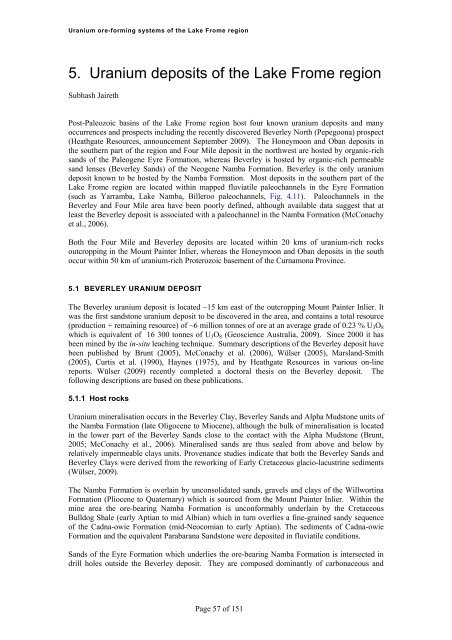Uranium ore-forming systems of the - Geoscience Australia
Uranium ore-forming systems of the - Geoscience Australia
Uranium ore-forming systems of the - Geoscience Australia
You also want an ePaper? Increase the reach of your titles
YUMPU automatically turns print PDFs into web optimized ePapers that Google loves.
<strong>Uranium</strong> <strong>ore</strong>-<strong>forming</strong> <strong>systems</strong> <strong>of</strong> <strong>the</strong> Lake Frome region5. <strong>Uranium</strong> deposits <strong>of</strong> <strong>the</strong> Lake Frome regionSubhash JairethPost-Paleozoic basins <strong>of</strong> <strong>the</strong> Lake Frome region host four known uranium deposits and manyoccurrences and prospects including <strong>the</strong> recently discovered Beverley North (Pepegoona) prospect(Heathgate Resources, announcement September 2009). The Honeymoon and Oban deposits in<strong>the</strong> sou<strong>the</strong>rn part <strong>of</strong> <strong>the</strong> region and Four Mile deposit in <strong>the</strong> northwest are hosted by organic-richsands <strong>of</strong> <strong>the</strong> Paleogene Eyre Formation, whereas Beverley is hosted by organic-rich permeablesand lenses (Beverley Sands) <strong>of</strong> <strong>the</strong> Neogene Namba Formation. Beverley is <strong>the</strong> only uraniumdeposit known to be hosted by <strong>the</strong> Namba Formation. Most deposits in <strong>the</strong> sou<strong>the</strong>rn part <strong>of</strong> <strong>the</strong>Lake Frome region are located within mapped fluviatile paleochannels in <strong>the</strong> Eyre Formation(such as Yarramba, Lake Namba, Billeroo paleochannels, Fig. 4.11). Paleochannels in <strong>the</strong>Beverley and Four Mile area have been poorly defined, although available data suggest that atleast <strong>the</strong> Beverley deposit is associated with a paleochannel in <strong>the</strong> Namba Formation (McConachyet al., 2006).Both <strong>the</strong> Four Mile and Beverley deposits are located within 20 kms <strong>of</strong> uranium-rich rocksoutcropping in <strong>the</strong> Mount Painter Inlier, whereas <strong>the</strong> Honeymoon and Oban deposits in <strong>the</strong> southoccur within 50 km <strong>of</strong> uranium-rich Proterozoic basement <strong>of</strong> <strong>the</strong> Curnamona Province.5.1 BEVERLEY URANIUM DEPOSITThe Beverley uranium deposit is located ~15 km east <strong>of</strong> <strong>the</strong> outcropping Mount Painter Inlier. Itwas <strong>the</strong> first sandstone uranium deposit to be discovered in <strong>the</strong> area, and contains a total resource(production + remaining resource) <strong>of</strong> ~6 million tonnes <strong>of</strong> <strong>ore</strong> at an average grade <strong>of</strong> 0.23 % U 3 O 8which is equivalent <strong>of</strong> 16 300 tonnes <strong>of</strong> U 3 O 8 (<strong>Geoscience</strong> <strong>Australia</strong>, 2009). Since 2000 it hasbeen mined by <strong>the</strong> in-situ leaching technique. Summary descriptions <strong>of</strong> <strong>the</strong> Beverley deposit havebeen published by Brunt (2005), McConachy et al. (2006), Wülser (2005), Marsland-Smith(2005), Curtis et al. (1990), Haynes (1975), and by Heathgate Resources in various on-linereports. Wülser (2009) recently completed a doctoral <strong>the</strong>sis on <strong>the</strong> Beverley deposit. Thefollowing descriptions are based on <strong>the</strong>se publications.5.1.1 Host rocks<strong>Uranium</strong> mineralisation occurs in <strong>the</strong> Beverley Clay, Beverley Sands and Alpha Mudstone units <strong>of</strong><strong>the</strong> Namba Formation (late Oligocene to Miocene), although <strong>the</strong> bulk <strong>of</strong> mineralisation is locatedin <strong>the</strong> lower part <strong>of</strong> <strong>the</strong> Beverley Sands close to <strong>the</strong> contact with <strong>the</strong> Alpha Mudstone (Brunt,2005; McConachy et al., 2006). Mineralised sands are thus sealed from above and below byrelatively impermeable clays units. Provenance studies indicate that both <strong>the</strong> Beverley Sands andBeverley Clays were derived from <strong>the</strong> reworking <strong>of</strong> Early Cretaceous glacio-lacustrine sediments(Wülser, 2009).The Namba Formation is overlain by unconsolidated sands, gravels and clays <strong>of</strong> <strong>the</strong> WillwortinaFormation (Pliocene to Quaternary) which is sourced from <strong>the</strong> Mount Painter Inlier. Within <strong>the</strong>mine area <strong>the</strong> <strong>ore</strong>-bearing Namba Formation is unconformably underlain by <strong>the</strong> CretaceousBulldog Shale (early Aptian to mid Albian) which in turn overlies a fine-grained sandy sequence<strong>of</strong> <strong>the</strong> Cadna-owie Formation (mid-Neocomian to early Aptian). The sediments <strong>of</strong> Cadna-owieFormation and <strong>the</strong> equivalent Parabarana Sandstone were deposited in fluviatile conditions.Sands <strong>of</strong> <strong>the</strong> Eyre Formation which underlies <strong>the</strong> <strong>ore</strong>-bearing Namba Formation is intersected indrill holes outside <strong>the</strong> Beverley deposit. They are composed dominantly <strong>of</strong> carbonaceous andPage 57 <strong>of</strong> 151
















